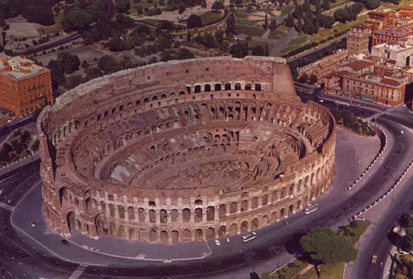ROME SIGHTS
Colosseum
Roman Forum
Sistine Chapel
Trevi Fountain
St Peters Square
Basilica
Vatican Museums
Pantheon
Piazza Navona
Spanish Steps
ODD ROME
Knights Of Malta Keyhole
VISIT THE WORLD FAMOUS...
EuroBlog!!!!!
|
|

The Colosseum
Distance from hotel: 3.4 miles (About 14 minutes)
Hours of operation:
Cost:
Included with tour: Yes
THE HISTORY
The Amphitheatrum Flavium, a.k.a. Colosseum or Coliseum (though
in the antiquity Romans referred to it as to Amphitheatrum Caesareum or
hunting theater), was built by the Flavian emperors in the first century
AD as a gift to the Roman citizens, in the place where the previous
Emperor Nero (37-68 AD) had built his residence, the Domus Aurea.
The city needed an amphitheatre, as the only one with a (partially) stone
structure had been built by Statilius Taurus in 29 BC and it was too
small. The emperor Caligula (12-41 AD) had started the works for a new
amphitheatre, but Claudius (10-54 AD) stopped them when he came to power.
Nero, too, refused to use the old Statilius' facility and preferred to
have his own amphitheatre built in the Campus Martis. It was a beautiful
one, according to the historians, but it was destroyed, probably in the
famous fire of AD 64.
Nero's death in 68 marked the end of the Julio-Claudian dinasty; the
Flavian family came to power. The emperor Vespasian was acknowledged as
emperor by the Senate in 69, and wanted to make a political gesture to
reconcile the Roman citizens with the new masters. So he gave back to the
Romans most of the land that Nero had occupied in the centre of the city,
and the Colosseum was built in the place where before was an artificial
lake, in the park of Nero's residence.
It took about ten years to build the amphitheatre. Vespasian
started the works in 72 AD and his son
Titus dedicated it in the year 80 with magnificent games that lasted one
hundred days. It is generally accepted that the building was completed by
the following emperor, Domitian, Titus' brother.
In the amphitheatre, a Roman invention, were held games; the most
popular were the venationes (hunts) and the munera
(gladiatorial games). The Roman ruling class was obliged, by law and by
the expectation of the people, to organize games, also to gain the favour
of the citizens. The organization of the games, which involved great
expenses, became a matter of public interest and was regulated by many
laws.
The whole area was dedicated to the games; near the Colosseum Domitian
also built four ludi, the prisons where gladiators had their
training. The bestiarii, who fought against the beasts, were in
the Ludus matutinus, so called because the show with the animals
was held in the morning. Then there was the Ludus Gallicus, the
Ludus Dacicus and the Ludus Magnus.
The Colosseum remained in service for four and a half centuries; there is
evidence of many changes, additions and
repairs. Once, in 217, the upper floors went on fire because of a
thunderbolt, and for five years the shows were held at the circus. There
also were many earthquakes (in 442, 470, and 847).
The last gladiatorial combat is recorded in 404, and the last hunt in
523. Gradually the taste of the public had changed, but the main reason
for the end of the games was the military and financial crisis of the
western part of the empire, together with the many invasions Italy
suffered. Nobody could bear anymore the colossal expenses needed to
organize the shows, and this made the function of the building obsolete.
Perhaps some venatio was held until the end of the VII century (Gentili),
but in the VIII-IX centuries the amphitheatre was completely abandoned.
During the middle ages houses and churches were built in the Colosseum,
that was also used as a fortress/residence by the barons of Rome. Its
destruction was hastened during the renaissance and later by its use as a
source of building materials, until restoration started again in the
eighteenth century, and has never stopped since.
|
